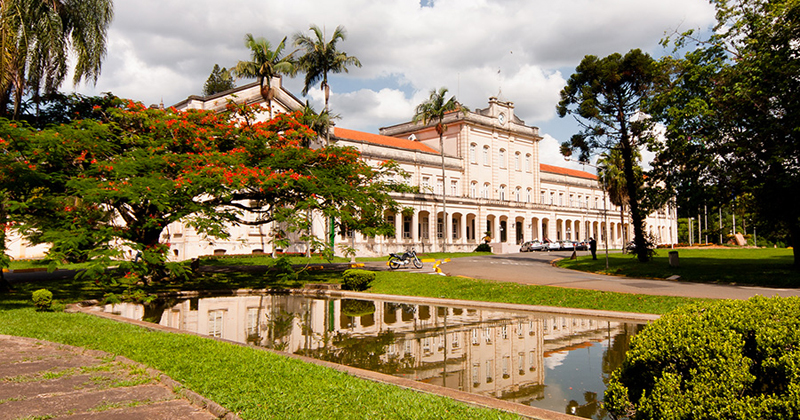ESALQ celebrates 120 years of history

photo: Gerhard Waller / USP Journal
On a June 3ʳᵈ virtual ceremony, the Luiz de Queiroz College of Agriculture (ESALQ) celebrated 120 years of history. One of Brazil’s oldest higher education institutes, as well as one of USP’s founding institutions, it plays a fundamental role as Brazil’s international reference in agricultural sciences. You can learn more about ESALQ here.
On June 3ʳᵈ, the Escola Superior de Agricultura Luiz de Queiroz (ESALQ), also known as the Luiz de Queiroz College of Agriculture, celebrated 120 years of history. One of University of São Paulo (USP) oldest campuses, it held a virtual 120th anniversary celebration attended by USP’s President Vahan Agopyan and USP’s Vice-President Antonio Carlos Hernandes. The program of the event included tributes, inaugurations, homages and the publication of two books related to research on campus. The celebration can be found in Portuguese at ESALQ YouTube account or through this link.
Located in Piracicaba, a city in the countryside of São Paulo State 150 km (around 100 miles) northwest of the city of São Paulo, ESALQ was founded in 1901. Back then, a farmer and businessman named Luiz Vicente de Souza Queiroz donated his farm to the São Paulo State Government, hoping to create a school of agriculture. The land, called Fazenda São João da Montanha, became the well-known Escola Agrícola Prática de Piracicaba, later named ESALQ.
The school was integrated into the University of São Paulo in 1934 as one of its founding institutions. The Piracicaba Campus covers 9,200 acres of land, which is equivalent to about 48% of all USP campuses. Its structure includes facilities such as a restaurant, a computer lab, medical and dental services, libraries, and a sports center. The Center for Nuclear Energy in Agriculture (CENA) is also a part of the Piracicaba Campus, as are four experimental stations scattered around São Paulo state.
Ever since its foundation, ESALQ has been at the forefront of agricultural sciences and academic production in Brazil. In 1964, it became the first USP Institute to offer graduate courses, which have welcomed more than nine thousand students. Nowadays, ESALQ offers fifteen graduate programs, one of which is international.
Today, the campus also offers seven undergraduate courses and has awarded degrees to over fifteen thousand students. Equipped with 130 laboratories and 12 departments, ESALQ hosts studies ranging from agricultural productivity to environmental, biological and societal impacts of agricultural production.
ESALQ’s participation in the international scene can be recognized through its agreements with foreign institutions, student and faculty exchange programs, and the double degree programs in Agriculture and Food Science with French institutions.
The campus also impresses for its beauty, so much so that in December 2006 part of it was classified as public heritage of the State of São Paulo by the State council for historical, archeological, artistic and touristic preservation (Condephaat).
The architecture of the main campus building is especially remarkable. Designed in 1895 by José Van Humbeeck, a São Paulo State civil servant, the building has undergone many adaptations throughout its history, only recently becoming a preservation site under the care of São Paulo State.

photo: Marcos Santos / USP Images
ESALQ also has an extensive and impressive green area and its park is based upon an English model of landscaping. It was idealised by Belgian architect and ESALQ professor Arsène Puttmans at the start of the 20th century. It induces the observer to believe in the illusion that the park is a dense woodland, an aspect maintained for more than a hundred years.
You can learn more about ESALQ in the institutional video below:
